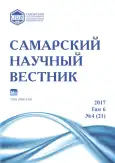Permanent and temporary expositions of succulents in the Botanical Garden of Peter the Great as a way of biological and ecological education
- Authors: Kalugin Y.G.1, Musinova L.P.1
-
Affiliations:
- V.L. Komarov Botanical Institute of Russian Academy of Sciences
- Issue: Vol 6, No 4 (2017)
- Pages: 222-227
- Section: 13.00.00 – Pedagogical Sciences
- URL: https://journals.rcsi.science/2309-4370/article/view/22358
- DOI: https://doi.org/10.17816/snv201764305
- ID: 22358
Cite item
Full Text
Abstract
The paper describes one of the ways of organizing educational activities in the expositions of the Peter the Great Botanical Garden in St. Petersburg. The authors study the problem of actualization of environmental knowledge among the population and preservation of biodiversity through leisure. The paper analyzes educational work in Russian botanical gardens and some foreign gardens at the present time. The authors introduce the term «complex garden» as a garden of broad educational opportunities. The paper describes a collection of plants of one of the oldest and largest botanical gardens in Russia. The authors demonstrate a variety of topics for study, detail the content of exhibitions and describe the ways of active and passive activity of visitors on the example of expositions of succulent plants. The paper provides a diagram of ecological and biological knowledge improvement.
Full Text
##article.viewOnOriginalSite##About the authors
Yuri Guryanovich Kalugin
V.L. Komarov Botanical Institute of Russian Academy of Sciences
Author for correspondence.
Email: kalugin_yuri@list.ru
researcher
Russian Federation, Saint PetersburgLarisa Petrovna Musinova
V.L. Komarov Botanical Institute of Russian Academy of Sciences
Email: larmuss@rambler.ru
methodist of Cultural and Educational Center
Russian Federation, Saint PetersburgReferences
- The Global Strategy for Plant Conservation: 2011-2020 // Published by Botanic Gardens Conservation International for the Convention on Biological Diversity, September 2012. Richmond, UK.
- Национальная Стратегия сохранения биоразнообразия России [Электронный ресурс] // Министерство природных ресурсов России. - http://caresd.net/ img/docs/530.pdf.
- Dodd J., Jones C. Redefining the role of botanic gardens - towards a new social purpose. Research Centre for Museums and Galleries (RCMG), BGCI, 2010. 142 p.
- Наумцев Ю.В. Ботанический сад - место, в котором живет душа // Сады в наших сердцах: коллективная монография по материалам 3-й междунар. конф. «Жизнь в гармонии: ботанические сады и общество - диалог без границ». Тверь, Россия, 13-16 октября 2013 г. Тверь: Полипресс, 2013. С. 122-130.
- Андреева А.Е., Дубенюк А.П., Паршин А.Ю., Ретеюм А.А. Проведение выставок и фестивалей как ключевой элемент стратегии развития ботанического сада // Ботанические сады в современном мире: наука, образование, менеджмент: мат-лы Первой междунар. науч.-практ. конф. 22-26 июня 2016 г., Санкт-Петербург, Россия. СПб.: ООО «Полиграфический комплекс», 2016. С. 52-56.
- Bowker R. Children’s perceptions of plants following their visit to the Eden Project. Research in Science and Technological Education, 22 (2), 2004. P. 227-243.
- South M. Can a botanic garden education visit increase children’s environmental awareness? // L.A. Sutherland, T.K. Abraham, J. Thomas (Eds.), The power for change: Botanic gardens as centres of excellence in education for sustainability. Proceedings of the 4th International Congress on Education in Botanic Gardens. Richmond, Surrey: Botanic Gardens Conservation International, 1999. P. 68-76.
- Dr. Paul Keßler and Hanneke Jelles. A walk in the park? Science, young people and the hortus. BGCI, 2017. Roots. Vol. 14 (1). P. 17-19.
- Sanders D. Making public the private life of plants: The contribution of informal learning environments. International Journal of Science Education, 29 (10), 2007. P. 1209-1228.
- Калугин Ю.Г., Мусинова Л.П. Особенности ведения научно-просветительской работы в Ботаническом саду Петра Великого // Роль ботанических садов и дендрариев в сохранении, изучении и устойчивом использовании разнообразия растительного мира: мат-лы междунар. науч. конф., посв. 85-летию Центрального ботанического сада Национальной академии наук Беларуси (г. Минск, 6-8 июня 2017 г.). В 2 ч.Ч. 1 / Национальная академия наук Беларуси; Центральный ботанический сад; редкол.: В.В. Титок [и др.]. Мн.: Медисонт, 2017. С. 393-397.
- Арнаутова Е.М., Романова Е.Л. Оранжереи Ботанического сада Петра Великого. СПб.: ООО «Первый издательско-полиграфический холдинг», 2016. 68 с.
- Olin P., Schneider E. Administering the public garden // Сады в наших сердцах: Коллективная монография по материалам 3-й междунар. конф. «Жизнь в гармонии: ботанические сады и общество - диалог без границ». Тверь, Россия, 13-16 октября 2013 г. «Издательство Полипресс», 2013. С. 74-86.
- National Botanic Garden of Wales [El. resource] // https://botanicgarden.wales.
- Singapore Botanic Gardens [El. resource] // https://sbg.org.sg.
- The New York Botanical Garden [El. resource] // https://nybg.org.
- Tegegn Argaw Opportunities of Botanical Garden in Environmental and Development Education to Support School Based Instruction in Ethiopia. Journal of Biology, Agriculture and Healthcare. 2015. Vol. 5, № 15. P. 92-109.
- Tunnicliffe S.D. Talking about plants: Comments of primary school groups looking at plant exhibits in a botanical garden // Journal of Biological Education. 2001. 36 (1). P. 27-34.
- Peter Wyse Jackson The developing role of botanic gardens in plant conservation: implementing the global strategy for plant conservation // Сады в наших сердцах: Коллективная монография по материалам 3-й междунар. конф. «Жизнь в гармонии: ботанические сады и общество - диалог без границ». Тверь, Россия, 13-16 октября 2013 г. Тверь, 2013. С. 35-51.
Supplementary files







